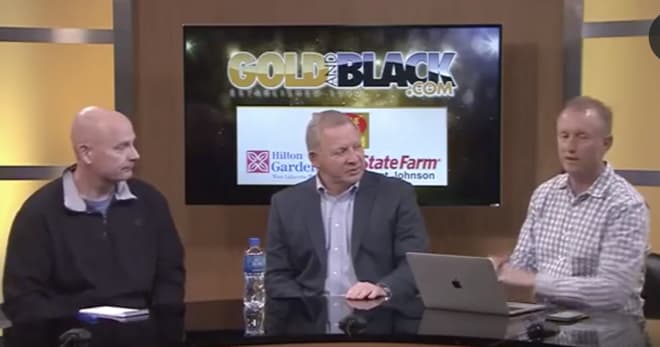

GoldandBlack.com's Alan Karpick and Tom Dienhart caught up with Purdue athletics director Mike Bobinski to get his thoughts on recruiting, the state of Boilermaker athletics and much more. Today's first part of a two-part interview talks about recruiting, the athletic experience and Bobinski's view on the transfer portal.
Karpick: Talk about the significance of this recruiting class.
Bobinski: As Jeff (Brohm) has said many times and is apparent to all of us that pay close attention to the program, one of the challenges we had this year was the ability to have quality depth. As we layer class after class after class, you look ahead and see that once these young guys start to mature and develop in a way that you would hope they would, we’re going to be a program that, down the road when you have injuries, you’ll be able to just sort of “plug and play” without the drop-off that we experienced this year.
Guys weren’t quite ready yet. It’s not that they lacked talent, it’s just readiness and physical preparation and maturity (that was lacking). We want to get to a point where we can sustain the things that are inevitably going to happen. Everyone has injuries. I’m not moaning and groaning about that. It’s a contact sport. But you have to have your program established and mature enough to sustain them and just keep on keeping on without it being a setback.
Dienhart: How involved are you in recruiting?
Bobinski: I am as involved as the football staff wants me to be. More often than not, it will be with specific prospects when they come on campus. It may be a parent, a coach, family, whatever it might be, they’ll ask me to come in and visit with them and talk about the broader Purdue experience and what our vision is for the program. I love doing that. It is an easy thing to talk about, all the positives, what a Purdue experience and opportunity can mean to them. I do it whenever asked. It’s not just for football, it’s for other sports as well.
Karpick: .So much has changed, not just to Purdue, but in the landscape of recruiting. To get the kids you want to get in here, you have to be nimble and you have to be ready at all times.
Bobinski: No question, and I think our guys do a great job. I’ve been with Jeff and multiple other coaches on the staff, and it doesn’t matter what day, what time, that phone is on fire. There is always something. There’s always an exchange or something that relates to recruiting, one way or another, that is going on. It’s virtually a non-stop enterprise. You are reacting to things that are happening. You’re trying to get out front and anticipate opportunities or challenges and put yourself in the very best position. I think our guys are tuned into that as you can possibly be.
Dienhart: There are a lot of bells and whistles for Jeff and company to sell. If you can say, what other bells and whistles does he ask you for that he thinks would really enhance his sales pitch.
Bobinski: Jeff is as low-maintenance and no frills when it comes to that. He would tell you that, and he’s told me multiple times that we have what we need. And I ask him to let us know if there is a gap somewhere that we can help try to address, then let’s do so. For Purdue, it’s about the opportunity to get a Purdue degree and the preparation that gives you as you move on in life. We’ve invested more and more in that side of things. We hired Peyton Stovall (assistant athletic director-student development) last year, and his job is not to win games. His job is to provide an opportunity and experience from the day they get here to the day they leave that prepares them for life after athletics. And who better to do that than a guy like him, who was a great basketball player, who probably would have made a living for some years, whether it be in the NBA or overseas, but couldn’t because he had devastating knee injuries. He’s from a place of real-life experience of where he thought he was going versus what happened. Making sure that he and others that work with him provide that experience, like Cathy Wright-Eger and others that work in that same effort, is as important as anything we can provide like a shiny new object thing.
Dienhart: I spoke to Markus Bailey in an exit interview, and I asked him what person influenced him the most while he was at Purdue, and he said Sean Pugh. He is obviously a huge asset to the football program, a guy that is just there for people to listen, to be counseled.
Bobinski: That’s all part of that same effort. Sometimes, they want to speak to someone who has no influence or no impact on playing time, but just provide them with a friendly ear with some advice and support if things are happening in their life that are challenges. Everybody has it, everybody’s got stuff. I think Jeff (Brohm) bringing Sean with him and investing in that position is a sign of our commitment to us helping these guys with whatever comes their way during their time here at Purdue.
Karpick: And your two relatively new sports psychologists, as well. It’s different as a student-athlete dealing with today's pressures.
Bobinski: It is very different. I met with our student-athlete advisory group last week, and I told them my experience as a student-athlete and how it is today, it’s night and day different. There’s almost no comparison.
(Today) They come in with these expectations that they are expected to live up to. The instantaneous feedback (on social media) that people get these days, wanted or unwanted, rude or civil, and all of that comes at them. Equipping them with the tools and skills to be able to deal with that and put it aside and make it productive, not destructive, is part of our jobs these days. It’s a new part of our jobs, but it’s part of it.
Dienhart: From a mental health aspect, are there any other personnel gaps in the athletic department that you foresee?
Bobinski: I don’t think there is anything that is a complete miss right now. I think there were a lot of good things in place, and I think when you look at it today, you don’t say, 'Wow, we don’t have anyone doing that.' I think we have someone doing everything that needs to be done.
Now do we have enough of everything? I think that’s something we evaluate as we go forward, day-in and day-out. It’s all availability of resources, what can we support and what can we afford to do, and that’s a reality of our operation. With Dr. (Kelsey) Dawson and Dr. (Brad) Foltz in our sports psychology area, they got on board and have been full 8 a.m. to 5 p.m. , all day, every day.
Karpick: What is your take from transfer portal and redshirt rules. How do you see that, from your perspective, evolving? Is it a good thing, from your perspective?
Bobinski: I think there are multiple sides to that whole debate. I think the transfer portal, as a mechanism, is a better system than we had before. Having to go ask for permission to transfer and, 'May I go to this school, or that school, or the other school?' created a really weird dynamic that wasn’t working very well in the modern era. People want more flexibility and want more freedom, and the system didn’t provide that. The transfer portal provides that. They no longer have to ask for permission. The student-athlete can make a decision that they want to explore other opportunities.
Now on the opposite side, we can say that it is fine and we can reduce or pull back their aid and move on to the next opportunity for us. And I think that’s fair. I think the transfer portal, itself, is fine as a mechanism. I don’t think in and of itself, that has exacerbated the transfer frequency. That was coming anyway. That was already here. There was so much of an expectation that if they go to school X, and if they weren’t playing right away (a student-athlete might look at other options). The lack of patience and putting in your time and waiting for your opportunity is a new thing. The string’s gotten shorter and shorter, and everyone wants the immediate opportunity and immediate gratification, whether they are ready or not. And when there are people in their ear, either back home or elsewhere, asking why they’re not playing, and there’s all the noise aggravated the transfer situation. I don’t have an answer to that, that’s just part of the environment.
I, personally, would like to see us move towards every student-athlete having the opportunity to transfer one time and be immediately eligible in every sport. Now you currently have that in a bunch of sports with the exception of football, men’s and women’s basketball, baseball, and maybe one or two others.
. I think you ought to be able to do it for everyone (no matter the sport), and that count for your graduate year, undergraduate year. You sort of get one mulligan, one opportunity to say that you made a bad choice or that there is a better opportunity somewhere else. If you do it a second time, you can still do it, but you sit a year the second time. That’s my one-size-fits-all view. I think if the Big Ten ever gets a chance to advance that, we will.

Membership Info: Sign up for GoldandBlack.com now | Why join? | Questions?
Follow GoldandBlack.com: Twitter | Facebook | YouTube
More: Gold and Black Illustrated/Gold and Black Express | Subscribe to our podcast
Copyright, Boilers, Inc. 2019. All Rights Reserved. Reproducing or using editorial or graphical content, in whole or in part, without permission, is strictly prohibited.
